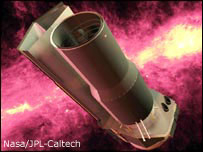A $2 billion space observatory that may study the early history of the universe will be launched by NASA on Monday. It will join the Hubble Space Telescope operating in the visible light range and the X-ray and gamma-ray observatories (respectively) Chandra and Compton
 A $2 billion space observatory that may study the early history of the universe will be launched by NASA on Monday. It will join the Hubble Space Telescope operating in the visible light range and the X-ray and gamma-ray observatories (respectively) Chandra and Compton. The name of the telescope was changed to Spitzer.
A $2 billion space observatory that may study the early history of the universe will be launched by NASA on Monday. It will join the Hubble Space Telescope operating in the visible light range and the X-ray and gamma-ray observatories (respectively) Chandra and Compton. The name of the telescope was changed to Spitzer.
The new observatory SIRTF, an acronym for the Space Infrared Telescope Facility (Space Infrared Telescope Facility), will locate the energy in the infrared field, which is actually heat energy, emitted by stars, galaxies and planets.
Astronomers will be able to study the distant objects hidden by gas and dust, and cannot be detected with telescopes operating in visible light. Young stars ejected from dusty galaxies that existed when the universe was between 2-3 billion years old are of particular interest.
The observatory will launch into space on a Delta 2 rocket from Cape Canaveral, Florida. The launch is scheduled for the early hours of Monday.
SIRTF will be the largest and most sensitive infrared telescope ever launched into space. It will circle the Earth between two and five years and look further into space. The researchers intend to use the telescope to conduct a survey of all distant galaxies within 10 billion light years. "The telescope will allow us to see through the dust," said Dr. Sebastian Oliver from the Center for Astronomy at the University of Sussex. "This will allow us to study objects that would otherwise be hidden."
Astronomers will be able to look back in time to a time when the universe was a violent place and many new stars were born. says Michael Rowan-Robinson of Imperial College London. "By looking back at the universe through 90 percent of its history, we can study the time when stars formed much more frequently than today." said. "This will allow us to follow the evolution of star formation from early time."
The SIRTF launch marks the completion of NASA's Large Observatory Program. The Hubble Space Telescope, the Chandra X-ray Observatory, and the Compton Gamma-ray Observatory were the other sides of the quadrangle, each surveying the universe at different wavelengths. Two are still active but Compton was decommissioned in June 2000. The European Space Agency plans to launch a large infrared telescope - Herschel - in 2007.
Continued
The space agency NASA launched this morning (Monday) from its base in Cape Canaveral, Florida, an unmanned research space vehicle whose purpose is to study the early history of the universe.
The facility is equipped with a special infrared telescope, capable of detecting energy emitted from stars, planets and galaxies. The space vehicle
"The expectation is to revolutionize our understanding of the universe by looking at it from a shorter range," said Dave Gallagher, project manager at NASA.
The special space telescope, which is sensitive to temperatures, will aim for darkness and will be able to discover stars that have never "lighted up", or those that do not have enough heat to shine. The telescope will cool itself to a temperature of a degree or two above absolute zero, thus detecting the darkest and coldest stars, which have never been seen before.
This is the development of a tripartite project by NASA, called "Large Star Observatories". The project also includes the "Hubble" space telescope, which works on sensitivity to light, and the "Chandra" X-Ray device. Through these three facilities, the astronauts will be able to get the complete picture about the matter and energy in the universe.
Ann Kinney, a scientist at NASA, explained that when the three telescopes are in space, the "Chandra" will be able to detect objects at millions of degrees of heat, the "Hubble" will be able to detect objects at thousands of degrees and the new telescope, known as SIRTF (acronym for Space Infra Red Telescope Facility), will be able to detect objects whose temperature reaches hundreds of degrees only. "This way we will get a large range of information about what is there," Kinney said.
The new telescope, which will receive a more "accessible" name after proving itself for about two months in space, will also play an important role closer to Earth. Scientists know very little about a wide region of ice-covered objects orbiting the Sun, beyond the orbit of the planet Pluto. From this region, known as the "Kuiper Belt", ice balls sometimes reach the solar system and become comets, after they are heated by the sun. Now, with the telescope, it will be possible to examine the subject while observing the orbit around the earth, without the radiation from it interfering.
